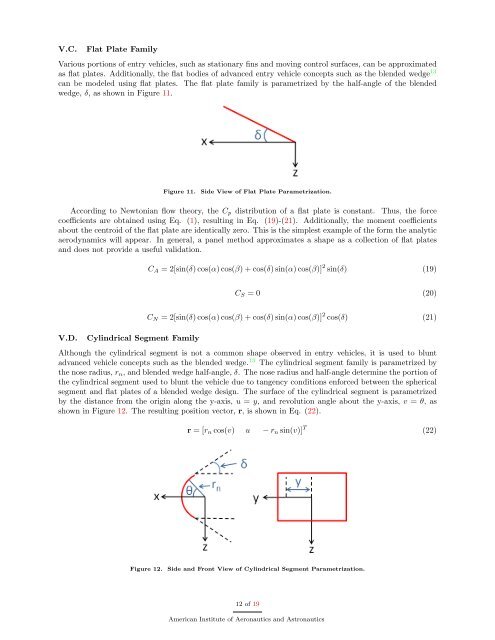Analytic Hypersonic Aerodynamics for Conceptual Design of Entry ...
Analytic Hypersonic Aerodynamics for Conceptual Design of Entry ...
Analytic Hypersonic Aerodynamics for Conceptual Design of Entry ...
You also want an ePaper? Increase the reach of your titles
YUMPU automatically turns print PDFs into web optimized ePapers that Google loves.
V.C. Flat Plate Family<br />
Various portions <strong>of</strong> entry vehicles, such as stationary fins and moving control surfaces, can be approximated<br />
as flat plates. Additionally, the flat bodies <strong>of</strong> advanced entry vehicle concepts such as the blended wedge 13<br />
can be modeled using flat plates. The flat plate family is parametrized by the half-angle <strong>of</strong> the blended<br />
wedge, δ, as shown in Figure 11.<br />
Figure 11. Side View <strong>of</strong> Flat Plate Parametrization.<br />
According to Newtonian flow theory, the Cp distribution <strong>of</strong> a flat plate is constant. Thus, the <strong>for</strong>ce<br />
coefficients are obtained using Eq. (1), resulting in Eq. (19)-(21). Additionally, the moment coefficients<br />
about the centroid <strong>of</strong> the flat plate are identically zero. This is the simplest example <strong>of</strong> the <strong>for</strong>m the analytic<br />
aerodynamics will appear. In general, a panel method approximates a shape as a collection <strong>of</strong> flat plates<br />
and does not provide a useful validation.<br />
V.D. Cylindrical Segment Family<br />
CA = 2[sin(δ) cos(α) cos(β) + cos(δ) sin(α) cos(β)] 2 sin(δ) (19)<br />
CS = 0 (20)<br />
CN = 2[sin(δ) cos(α) cos(β) + cos(δ) sin(α) cos(β)] 2 cos(δ) (21)<br />
Although the cylindrical segment is not a common shape observed in entry vehicles, it is used to blunt<br />
advanced vehicle concepts such as the blended wedge. 13 The cylindrical segment family is parametrized by<br />
the nose radius, rn, and blended wedge half-angle, δ. The nose radius and half-angle determine the portion <strong>of</strong><br />
the cylindrical segment used to blunt the vehicle due to tangency conditions en<strong>for</strong>ced between the spherical<br />
segment and flat plates <strong>of</strong> a blended wedge design. The surface <strong>of</strong> the cylindrical segment is parametrized<br />
by the distance from the origin along the y-axis, u = y, and revolution angle about the y-axis, v = θ, as<br />
shown in Figure 12. The resulting position vector, r, is shown in Eq. (22).<br />
r = [rn cos(v) u − rn sin(v)] T<br />
Figure 12. Side and Front View <strong>of</strong> Cylindrical Segment Parametrization.<br />
12 <strong>of</strong> 19<br />
American Institute <strong>of</strong> Aeronautics and Astronautics<br />
(22)

















